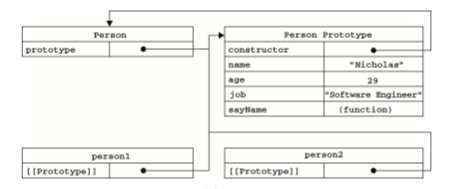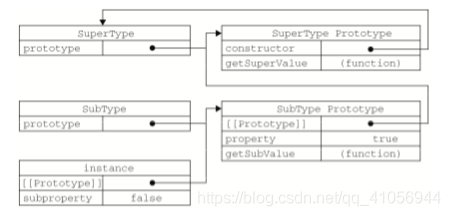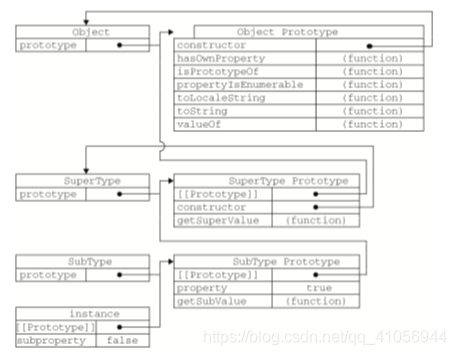面向对象的程序设计
理解对象
创建对象的两种方式:
第一种:创建一个Object对象并为它添加上属性和方法
var person = new Object();
person.name = "Nicholas";
person.age = 29;
person.job = "Software Engineer";
person.sayName = function(){
alert(this.name);
};第二种:对象字面量语法
var person = {
name: "Nicholas",
age: 29,
job: "Software Engineer",
sayName: function(){
alert(this.name);
}
};
两种属性类型:
第一种数据属性
- [[Configurable]]:表示能否通过 delete 删除属性从而重新定义属性,能否修改属性的特性,或者能否把属性修改为访问器属性。像前面例子中那样直接在对象上定义的属性,它们的这个特性默认值为 true。
- [[Enumerable]]:表示能否通过 for-in 循环返回属性。像前面例子中那样直接在对象上定义的属性,它们的这个特性默认值为 true。
- [[Writable]]:表示能否修改属性的值。像前面例子中那样直接在对象上定义的属性,它们的这个特性默认值为 true.
- [[Value]]:包含这个属性的数据值。读取属性值的时候,从这个位置读;写入属性值的时候,把新值保存在这个位置。这个特性的默认值为 undefined。
修改属性默认特性:Object.defineProperty(属性所属对象,属性的名字,描述符对象的属性)
var person = {};
Object.defineProperty(person, "name", {
writable: false,
value: "Nicholas"
});
alert(person.name); //"Nicholas"
person.name = "Greg";
alert(person.name); //"Nicholas"这个例子创建了一个名为 name 的属性,它的值"Nicholas"是只读的。这个属性的值是不可修改 的,如果尝试为它指定新值,则在非严格模式下,赋值操作将被忽略;在严格模式下,赋值操作将会导 致抛出错误。
注意:在调用 Object.defineProperty()方法时,如果不指定,configurable、enumerable 和writable 特性的默认值都是 false。
第二种访问器属性
- [[Configurable]]:表示能否通过 delete 删除属性从而重新定义属性,能否修改属性的特性,或者能否把属性修改为访问器属性。像前面例子中那样直接在对象上定义的属性,它们的这个特性默认值为 true。
- [[Enumerable]]:表示能否通过 for-in 循环返回属性。像前面例子中那样直接在对象上定义的属性,它们的这个特性默认值为 true。
- [[Get]]:在读取属性时调用的函数。默认值为 undefined。
- [[Set]]:在写入属性时调用的函数。默认值为 undefined。
修改属性默认特性:Object.defineProperty(属性所属对象,属性的名字,描述符对象的属性)
var book = {
_year: 2004,
edition: 1
};
Object.defineProperty(book, "year", {
get: function(){
return this._year;
},
set: function(newValue){
if (newValue > 2004) {
this._year = newValue;
this.edition += newValue - 2004;
}
}
});
book.year = 2005;
alert(book.edition); //2定义多个属性object.defineProperties(添加和修改其属性的对象,对象中要添加或修改的属性一一对应)
var book = {};
Object.defineProperties(book, {
_year: {
value: 2004
},
edition: {
value: 1
},
year: {
get: function(){
return this._year;
},
set: function(newValue){
if (newValue > 2004) {
this._year = newValue;
this.edition += newValue - 2004;
}
}
}
)};创建对象
- 工厂模式
- 构造函数模式
- 原型模式
- 组合使用构造函数模式和原型模式
- 动态原型模式
- 寄生构造函数模式
- 稳妥构造函数模式
工厂模式:
function createPerson(name, age, job){
var o = new Object();
o.name = name;
o.age = age;
o.job = job;
o.sayName = function(){
alert(this.name);
};
return o;
}
var person1 = createPerson("Nicholas", 29, "Software Engineer");
var person2 = createPerson("Greg", 27, "Doctor");缺陷:没有解决对象识别的问题(即怎样知道一个对象的类型)
构造函数模式
function Person(name, age, job){
this.name = name;
this.age = age;
this.job = job;
this.sayName = function(){
alert(this.name);
};
}
var person1 = new Person("Nicholas", 29, "Software Engineer");
var person2 = new Person("Greg", 27, "Doctor");与工厂模式的区别
- 没有显示创建对象
- 直接将属性和方法赋值给this对象
- 没有return语句
构造函数与其他函数的唯一区别,就在于调用它们的方式不同。不过,构造函数毕竟也是函数,不 存在定义构造函数的特殊语法。任何函数,只要通过 new 操作符来调用,那它就可以作为构造函数;而 任何函数,如果不通过 new 操作符来调用,那它跟普通函数也不会有什么两样。
// 当作构造函数使用
var person = new Person("Nicholas", 29, "Software Engineer");
person.sayName(); //"Nicholas"
// 作为普通函数调用
Person("Greg", 27, "Doctor"); // 添加到window
window.sayName(); //"Greg"
// 在另一个对象的作用域中调用
var o = new Object();
Person.call(o, "Kristen", 25, "Nurse"); o.sayName(); //"Kristen"缺陷:使用构造函数的主要问题,就是每个方法都要在每个 实例上重新创建一遍
然而,创建两个完成同样任务的 Function 实例的确没有必要;况且有 this 对象在,根本不用在 执行代码前就把函数绑定到特定对象上面。因此,大可像下面这样,通过把函数定义转移到构造函数外 部来解决这个问题。
function Person(name, age, job){
this.name = name;
this.age = age;
this.job = job;
this.sayName = sayName;
}
function sayName(){
alert(this.name);
}
var person1 = new Person("Nicholas", 29, "Software Engineer");
var person2 = new Person("Greg", 27, "Doctor");在这个例子中,我们把 sayName()函数的定义转移到了构造函数外部。而在构造函数内部,我们 将 sayName 属性设置成等于全局的 sayName 函数。这样一来,由于 sayName 包含的是一个指向函数 的指针,因此 person1 和 person2 对象就共享了在全局作用域中定义的同一个 sayName()函数。这 样做确实解决了两个函数做同一件事的问题,可是新问题又来了:在全局作用域中定义的函数实际上只 能被某个对象调用,这让全局作用域有点名不副实。而更让人无法接受的是:如果对象需要定义很多方 法,那么就要定义很多个全局函数,于是我们这个自定义的引用类型就丝毫没有封装性可言了。
原型模式prototype(原型)属性
function Person(){}
Person.prototype.name = "Nicholas";
Person.prototype.age = 29;
Person.prototype.job = "Software Engineer";
Person.prototype.sayName = function(){
alert(this.name);
};
var person1 = new Person();
person1.sayName(); //"Nicholas"
var person2 = new Person()
person2.sayName(); //"Nicholas"
alert(person1.sayName == person2.sayName); //true理解原型对象:
创建函数会自动创建一个prototype属性,该属性指向原型对象。默认情况下原型对象会自动创建一个constructor属性
该属性指向prototype属性所在的函数。
当调用构造函数创建一个新实例后,该实例内部包含一个指针,该指针指向构造函数的原型对象。es5中将该指针称为[[protoType]](该属性无法直接访问到)
注意点:这种链接只存在于实例和构造函数的原型对象之间,不存在约实例和构造函数之间

虽然在所有实现中都无法访问到[[Prototype]],但可以通过 isPrototypeOf()方法来确定对象之
间是否存在这种关系
alert(Person.prototype.isPrototypeOf(person1)); //true
alert(Person.prototype.isPrototypeOf(person2)); //trueECMAScript 5增加了一个新方法,叫Object.getPrototypeOf(),在所有支持的实现中,这个 方法返回[[Prototype]]的值
alert(Object.getPrototypeOf(person1) == Person.prototype); //true
alert(Object.getPrototypeOf(person1).name); //"Nicholas"hasOwnProperty()方法可以检测一个属性是存在于实例中,还是存在于原型中。这个方法(不 要忘了它是从 Object 继承来的)只在给定属性存在于对象实例中时,才会返回 true
function Person(){}
Person.prototype.name = "Nicholas";
Person.prototype.age = 29;
Person.prototype.job = "Software Engineer";
Person.prototype.sayName = function(){
alert(this.name);
};
var person1 = new Person();
var person2 = new Person();
alert(person1.hasOwnProperty("name")); //false
person1.name = "Greg";
alert(person1.name); //"Greg"——来自实例
alert(person1.hasOwnProperty("name")); //true
alert(person2.name); //"Nicholas"——来自原型
alert(person2.hasOwnProperty("name")); //false
delete person1.name;
alert(person1.name); //"Nicholas"——来自原型
alert(person1.hasOwnProperty("name")); //falsein 操作符会在通 过对象能够访问给定属性时返回 true,无论该属性存在于实例中还是原型中
function Person(){
}
Person.prototype.name = "Nicholas";
Person.prototype.age = 29;
Person.prototype.job = "Software Engineer";
Person.prototype.sayName = function(){
alert(this.name);
};
var person1 = new Person();
var person2 = new Person();
alert(person1.hasOwnProperty("name")); //false
alert("name" in person1); //true
person1.name = "Greg";
alert(person1.name); //"Greg" ——来自实例 alert(person1.hasOwnProperty("name")); //true alert("name" in person1); //true
alert(person2.name); //"Nicholas" ——来自原型 alert(person2.hasOwnProperty("name")); //false alert("name" in person2); //true
delete person1.name;
alert(person1.name); //"Nicholas" ——来自原型 alert(person1.hasOwnProperty("name")); //false alert("name" in person1); //truefor-in 循环时,返回的是所有能够通过对象访问的、可枚举的(enumerated)属性,其中 既包括存在于实例中的属性,也包括存在于原型中的属性。
Object.keys()方法取得对象上所有可枚举的实例属性,这个方法接收一个对象作为参数,返回一个包含所有可枚举属性的字符串数组
function Person(){
}
Person.prototype.name = "Nicholas";
Person.prototype.age = 29;
Person.prototype.job = "Software Engineer";
Person.prototype.sayName = function(){
alert(this.name);
};
var keys = Object.keys(Person.prototype);
alert(keys); //"name,age,job,sayName"
var p1 = new Person();
p1.name = "Rob";
p1.age = 31;
var p1keys = Object.keys(p1);
alert(p1keys); //"name,age"字面量原型语法
function Person(){}
Person.prototype = {
name : "Nicholas",
age : 29,
job : "Software Engineer",
sayName : function () {
alert(this.name);
};
};
//注意,以这种方式重设 constructor 属性会导致它的[[Enumerable]]特性被设置为 true。默认 情况,因此如果你使用兼容 ECMAScript 5 的 JavaScript 引 擎,可以试一试 Object.defineProperty()。下,原生的 constructor 属性是不可枚举的
//重设构造函数,只适用于 ECMAScript 5 兼容的浏览器
Object.defineProperty(Person.prototype, "constructor", {
enumerable: false,
value: Person
});缺陷:对于引用类型值的属性来说会导致多个实例共享同一个属性
function Person(){
}
Person.prototype = {
constructor: Person,
name : "Nicholas",
age : 29,
job : "Software Engineer",
friends : ["Shelby", "Court"],
sayName : function () {
alert(this.name);
} };
var person1 = new Person();
var person2 = new Person();
person1.friends.push("Van");
alert(person1.friends); //"Shelby,Court,Van"
alert(person2.friends); //"Shelby,Court,Van"
alert(person1.friends === person2.friends); //true在此,Person.prototype对象有一个名为friends的属性,该属性包含一个字符串数组。然后, 创建了 Person 的两个实例。接着,修改了 person1.friends 引用的数组,向数组中添加了一个字符 串。由于 friends 数组存在于 Person.prototype 而非 person1 中,所以刚刚提到的修改也会通过person2.friends(与 person1.friends 指向同一个数组)反映出来。假如我们的初衷就是像这样 在所有实例中共享一个数组,那么对这个结果我没有话可说。可是,实例一般都是要有属于自己的全部 属性的。而这个问题正是我们很少看到有人单独使用原型模式的原因所在。
结合使用构造函数模式和原型模式:
function Person(name, age, job){
this.name = name; 3 this.age = age;
this.job = job;
this.friends = ["Shelby", "Court"];
}
Person.prototype = {
constructor : Person,
sayName : function(){
alert(this.name);
}
}
var person1 = new Person("Nicholas", 29, "Software Engineer");
var person2 = new Person("Greg", 27, "Doctor");
person1.friends.push("Van");
alert(person1.friends); //"Shelby,Count,Van"
alert(person2.friends); //"Shelby,Count"
alert(person1.friends === person2.friends);//false
alert(person1.sayName === person2.sayName);//true
本质上讲通过构造函数模式用于定义实例属性,而原型模式用于定义方法和共享的属性。
动态原型模式:
function Person(name, age, job){
//属性
this.name = name;
this.age = age;
this.job = job;
//方法
if (typeof this.sayName != "function"){
Person.prototype.sayName = function(){
alert(this.name);
};
};
}
var friend = new Person("Nicholas", 29, "Software Engineer");
friend.sayName();
只在 sayName()方法不存在的情况下,才会将它添加到原 型中。这段代码只会在初次调用构造函数时才会执行。此后,原型已经完成初始化,不需要再做什么修改了
寄生构造模式:
这种模式 的基本思想是创建一个函数,该函数的作用仅仅是封装创建对象的代码,然后再返回新创建的对象;但 从表面上看,这个函数又很像是典型的构造函数。
function Person(name, age, job){
var o = new Object();
o.name = name;
o.age = age;
o.job = job;
o.sayName = function(){
alert(this.name);
};
return o;
}
var friend = new Person("Nicholas", 29, "Software Engineer");
friend.sayName(); //"Nicholas"本质上除了使用 new 操作符并把使用的包装函数叫做构造函数之外,这个模式跟工厂模式其实是一模一样的
该模式可以给原生构造函数加一层封装
function SpecialArray(){
//创建数组
var values = new Array()
//添加值
values.push.apply(values, arguments);
//添加方法
values.toPipedString = function(){
return this.join("|");
};
//返回数组
return values;
}
var colors = new SpecialArray("red", "blue", "green");
alert(colors.toPipedString()); //"red|blue|green"关于寄生构造函数模式,有一点需要说明:首先,返回的对象与构造函数或者与构造函数的原型属性之间没有关系;也就是说,构造函数返回的对象与在构造函数外部创建的对象没有什么不同。为此, 不能依赖 instanceof 操作符来确定对象类型。由于存在上述问题,我们建议在可以使用其他模式的情 况下,不要使用这种模式。
稳妥构建模式:
稳妥构造函数遵循与寄生构造函数类似的模式,但有两点不同:一是新创建对象的 实例方法不引用 this;二是不使用 new 操作符调用构造函数
function Person(name, age, job){
//创建要返回的对象
var o = new Object();
//可以在这里定义私有变量和函数
//。。。
//添加方法
o.sayName = function(){
alert(name);
};
//返回对象
return o;
}
var friend = Person("Nicholas", 29, "Software Engineer");
friend.sayName(); //"Nicholas"继承
- 原型链
- 借用构造函数
- 组合继承
- 原型式继承
- 寄生式继承
- 寄生组合式继承
原型链:
function SuperType(){
this.property = true;
}
SuperType.prototype.getSuperValue = function(){
return this.property;
};
function SubType(){
this.subproperty = false;
}
//继承了 SuperType
SubType.prototype = new SuperType();
SubType.prototype.getSubValue = function (){
return this.subproperty;
}
var instance = new SubType();
alert(instance.getSuperValue());//true
SubType原型对象的指针本来应该指向SubType函数,现在将SuperType实例赋值给SubType.prototyped,则此时SubType原型对象的指针指向SuperType原型对象了(SuperType实例的指针指向SuperType原型对象)
所有引用类型的都默认继承Object,以下是完整的原型链

两种确定原型与实例关系的方法:instanceof()、isPrototypeof()
instanceof 操作符,只要用 这个操作符来测试实例与原型链中出现过的构造函数,结果就会返回 true。
alert(instance instanceof Object);//true
alert(instance instanceof SuperType);//true
alert(instance instanceof SubType);//trueisPrototypeOf()方法。同样,只要是原型链中出现过的原型,都可以说是该 原型链所派生的实例的原型,因此 isPrototypeOf()方法也会返回 true
alert(Object.prototype.isPrototypeOf(instance));//true
alert(SuperType.prototype.isPrototypeOf(instance));//true
alert(SubType.prototype.isPrototypeOf(instance));//true
谨慎地定义方法:
function SuperType(){
this.property = true;
}
SuperType.prototype.getSuperValue = function(){
return this.property;
};
function SubType(){
this.subproperty = false;
}
//继承了 SuperType
SubType.prototype = new SuperType();
//添加新方法
SubType.prototype.getSubValue = function (){
return this.subproperty;
};
//重写超类型中的方法 SubType.prototype.getSuperValue = function (){
return false;
};
var instance = new SubType();
alert(instance.getSuperValue()); //false第一个方法 getSubValue()被添加到了 SubType中。第二个方法 getSuperValue()是原型链中已经存在的一个方法,但重写这个方法将会屏蔽原来的 那个方法。换句话说,当通过 SubType 的实例调用 getSuperValue()时,调用的就是这个重新定义 的方法;但通过 SuperType 的实例调用 getSuperValue()时,还会继续调用原来的那个方法。这里 要格外注意的是,必须在用 SuperType 的实例替换原型之后,再定义这两个方法。
注意:即在通过原型链实现继承时,不能使用对象字面量创建原型方法。因为这 样做就会重写原型链
function SuperType(){
this.property = true;
}
SuperType.prototype.getSuperValue = function(){
return this.property;
};
function SubType(){
this.subproperty = false;
}
//继承了 SuperType
SubType.prototype = new SuperType();
//使用字面量添加新方法,会导致上一行代码无效 SubType.prototype = {
getSubValue : function (){
return this.subproperty;
},
someOtherMethod : function (){
return false;
} };
var instance = new SubType();
alert(instance.getSuperValue()); //error!缺陷:最主要的问题来自包含引 用类型值的原型,另外在创建子类型的实例时,不能向超类型的构造函数中传递参数
function SuperType(){
this.colors = ["red", "blue", "green"];
}
function SubType(){
}
//继承了 SuperType
SubType.prototype = new SuperType();
var instance1 = new SubType();
instance1.colors.push("black");
alert(instance1.colors); //"red,blue,green,black"
var instance2 = new SubType();
alert(instance2.colors); //"red,blue,green,black"借用构造函数
function SuperType(){
this.colors = ["red", "blue", "green"];
}
function SubType(){
//继承了 SuperType
SuperType.call(this);
}
var instance1 = new SubType();
instance1.colors.push("black");
alert(instance1.colors); //"red,blue,green,black"
var instance2 = new SubType();
alert(instance2.colors); //"red,blue,green"在子类型构造函数中向超类型构造函数传递参数:
function SuperType(name){
this.name = name;
}
function SubType(){
//继承了 SuperType,同时还传递了参数
SuperType.call(this, "Nicholas");
//实例属性
this.age = 29;
}
var instance = new SubType();
alert(instance.name); //"Nicholas";
alert(instance.age); //29缺陷:如果仅仅是借用构造函数,那么也将无法避免构造函数模式存在的问题——方法都在构造函数中定 义,因此函数复用就无从谈起了。而且,在超类型的原型中定义的方法,对子类型而言也是不可见的,结果所有类型都只能使用构造函数模式。考虑到这些问题,借用构造函数的技术也是很少单独使用的。
组合继承
将原型链和借用构造函数的 技术组合到一块,从而发挥二者之长的一种继承模式。其背后的思路是使用原型链实现对原型属性和方法的继承,而通过借用构造函数来实现对实例属性的继承
function SuperType(name){
this.name = name;
this.colors = ["red", "blue", "green"];
}
SuperType.prototype.sayName = function(){
alert(this.name);
};
function SubType(name, age){
//继承属性 this.name、this.colors
SuperType.call(this, name);
this.age = age;
}
//继承方法 sayName()
SubType.prototype = new SuperType();
SubType.prototype.constructor = SubType;
SubType.prototype.sayAge = function(){
alert(this.age);
};
var instance1 = new SubType("Nicholas", 29);
instance1.colors.push("black");
alert(instance1.colors);//"red,blue,green,black"
instance1.sayName();//"Nicholas";
instance1.sayAge();//29
var instance2 = new SubType("Greg", 27);
alert(instance2.colors);//"red,blue,green"
instance2.sayName();//"Greg";
instance2.sayAge();//27原型式继承
借助原型可以基于已有的对象创建新对象,同时还不必因此创建自定义类型
function object(o){
function F(){};
F.prototype = 0;
return new F();
}在 object()函数内部,先创建了一个临时性的构造函数,然后将传入的对象作为这个构造函数的 原型,最后返回了这个临时类型的一个新实例。从本质上讲,object()对传入其中的对象执行了一次浅复制
var person = {
name: "Nicholas",
friends: ["Shelby", "Court", "Van"]
};
var anotherPerson = object(person);
anotherPerson.name = "Greg";
anotherPerson.friends.push("Rob");
var yetAnotherPerson = object(person);
yetAnotherPerson.name = "Linda";
yetAnotherPerson.friends.push("Barbie");
alert(person.friends); //"Shelby,Court,Van,Rob,Barbie"这种原型式继承,要求你必须有一个对象可以作为另一个对象的基础。如果有这么一个对象的话,可以把它传递给 object()函数,然后再根据具体需求对得到的对象加以修改即可。上述例子中person是基础对象
ECMAScript 5 通过新增 Object.create(对象,(可选)新对象定义额外属性的对象)方法规范化了原型式继承
var person = {
name: "Nicholas",
friends: ["Shelby", "Court", "Van"]
};
var anotherPerson = Object.create(person);
anotherPerson.name = "Greg";
anotherPerson.friends.push("Rob");
var yetAnotherPerson = Object.create(person);
yetAnotherPerson.name = "Linda";
yetAnotherPerson.friends.push("Barbie");
alert(person.friends); //"Shelby,Court,Van,Rob,Barbie"第二个参数与Object.defineProperties方法的第二个参数类型
var person = {
name: "Nicholas",
friends: ["Shelby", "Court", "Van"]
};
var anotherPerson = Object.create(person, {
name: {
value: "Greg"
}
});
alert(anotherPerson.name); //"Greg"寄生式继承
寄生式继承的思路与寄生构造函数和工厂模式类似
function createAnother(original){
varclone=object(original); //通过调用函数创建一个新对象
clone.sayHi = function(){ //以某种方式来增强这个对象
alert("hi");
};
return clone;//以某种方式来增强这个对象
}
//调用方式
var person = {
name: "Nicholas",
friends: ["Shelby", "Court", "Van"]
};
var anotherPerson = createAnother(person);
anotherPerson.sayHi(); //"hi"缺陷:由于不能做到函数复用而降低效率;这一 点与构造函数模式类似。
寄生组合式继承
即通过借用构造函数来继承属性,通过原型链的混成形式来继承方法。其背 后的基本思路是:不必为了指定子类型的原型而调用超类型的构造函数,我们所需要的无非就是超类型 原型的一个副本而已。本质上,就是使用寄生式继承来继承超类型的原型,然后再将结果指定给子类型 的原型。
function inheritPrototype(subType, superType){
var prototype = object(superType.prototype);//创建对象
prototype.constructor = subType;//增强对象
subType.prototype = prototype;//指定对象
}这个函数接收两 个参数:子类型构造函数和超类型构造函数。在函数内部,第一步是创建超类型原型的一个副本。第二步是为创建的副本添加 constructor 属性,从而弥补因重写原型而失去的默认的 constructor 属性。 最后一步,将新创建的对象(即副本)赋值给子类型的原型
function SuperType(name){
this.name = name;
this.colors = ["red", "blue", "green"];
}
SuperType.prototype.sayName = function(){
alert(this.name);
};
function SubType(name, age){
SuperType.call(this, name);
this.age = age;
}
inheritPrototype(SubType, SuperType);
SubType.prototype.sayAge = function(){
alert(this.age);
}